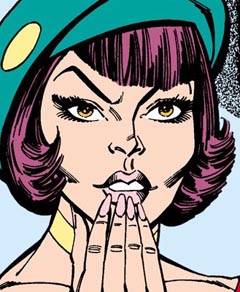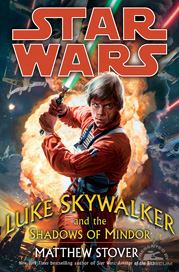Matthew Stover goes back to the beginning with “Luke Skywalker and the Shadows of Mindor” (December 2008, hardcover). Not the beginning of the “Star Wars” timeline, but the beginning of published “Star Wars” novels, as he attempts to capture the swashbuckling adventures of early “Star Wars” fiction.
He dedicates this book to Alan Dean Foster and the late Brian Daley, who wrote the first “Star Wars” novels in the late 1970s and early ’80s. Foster wrote “Splinter of the Mind’s Eye,” starring Luke and Leia, and Daley wrote the “Han Solo Adventures” trilogy. Stover thanks them for “showing us what it looks like when this stuff is done right.”
Like those early yarns, “Shadows of Mindor” isn’t a real crucial story in the galactic conflict between the Rebellion/Republic and the Empire. It’s a one-setting tale: Luke, in the post-“Return of the Jedi” era when he’s torn between his duties as a General and his need to rebuild the Jedi Order, travels to a dying, volcanic planet next to a flare-emitting sun.
In a nice bit of continuity, Stover re-introduces the Imperial agent Blackhole from the very first “Star Wars” comic strip by Russ Manning in 1979. It was reprinted in Dark Horse’s “Classic Star Wars: The Early Adventures” Nos. 1-3. Manning’s rather juvenile tales are for die-hard fans only, but I love Stover’s decision to bring back a mysterious, under-used character. He also brings back Nick Rostu from “Shatterpoint”; each “Star Wars” author has his or her own saga-within-the-saga now, and it’s kind of cool.
Stover is known for gritty character pieces: He also wrote “Traitor,” about Jacen Solo; “Shatterpoint,” about Mace Windu; and “Revenge of the Sith,” about Anakin Skywalker. In “Mindor,” Stover tries to figure out what makes Luke Skywalker tick. Just a few years ago, he was a whiny farm boy; a few years later, he’ll be a revered Jedi Master.
In “Mindor,” Luke is confident and surprisingly jokey as he takes on Blackhole; I like this characterization. Also, Han is in fine form, and this is the best book I’ve read chronicling his loving relationship with Leia without resorting to slapstick. Stover also gets Lando’s personality as a General just right — fun-loving, but also fast-talking and firm.
There are passages philosophizing on the nature of the Force from the perspective of Blackhole that get a bit long-winded (Stover muses about the nature of the Force in all of his novels, most effectively in “Traitor”). And we get yet another villain who wants to rule the galaxy (yawn) and a bunch of space battles (double yawn). Although Stover gets creative by inventing gravity-based weapons, I’ve just never been a fan of space battles via the written word; they really demand the kinetic energy of visual media.
But “Luke Skywalker and the Shadows of Mindor” is worth reading because we see Luke, Han, Leia and Lando in fine form. Stover isn’t in the same league as Daley, but he is on par with Foster, and I hope this isn’t his last Luke Skywalker novel.


